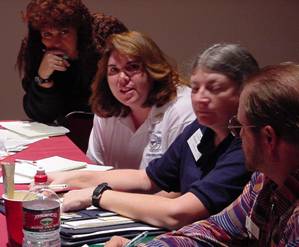Notes from
a Camp Organizer  Michele Makucevich (center), is shown here at the 2001 CMP-NRA-USAS National Coach Conference. Each year she organizes the very successful Rhode Island Junior Shooting Camp. In this article Michele provides a series of "notes" on how she organizes her camp. Organizing a camp requires a great deal of lead-time and the cooperation of numerous people. It, above all, requires careful planning. BUT, anyone who is organized and enthusiastic can put together a camp. Camps can be as big or small as the director wants them to be. One could begin by running a day clinic and expand to include overnight or multiple day experiences. One of the greatest tests of a successful camp is that, to the outside observer, things should run so smoothly that everything seems effortless. Still, there is not a single aspect of my camp that I have not given due consideration. Even in those areas that are less than perfect, careful thought went into them. For example, I deliberately separate the lectures from the range for two reasons. First, this gives the kids an opportunity to move to another location, thus providing a short break to stretch and talk. Second, most of the kids are more receptive to class work in a class environment. Conditioning, I guess. The length of lectures is also something I give a great deal of consideration to. In fact, until I have all of my applications in, I don't set the actual times. Sometimes I allow for 45 minutes. This year, with the median age of the athletes being 15 (the most classifications were "sharpshooter"), I set the time limit at 30 minutes. As a high school teacher, I can assure you that most of those kids would not be tuned in much beyond that. Having an overnight camp provides the kids with an opportunity to make friends with other shooters from, in some cases, different regions of the country. This is especially beneficial when they attend their first Junior Olympic National Championship and immediately recognize two or three people from our past camps. Selecting a variety of speakers also serves a number of purposes. For the kids, it allows them to obtain information from a variety of sources in an assortment of formats. It is also useful because more adult leaders have an opportunity to be validated as knowledgable. If the AMU shooters were the only speakers, it would devalue some of the other coaches. The kids need to feel that all of the coaches are equally important, because some of the kids will not have an AMU coach work directly with them. Certainly, a world-class athlete may address some of the finer points better than someone who has not competed internationally, but, usually, having a number of instructors give lectures works best. Sometimes I have guest speakers come to the camp. Last year, for example, I had a sports medicine expert come and give a GREAT presentation on non-gym related exercises that could strengthen those muscles most important in our sport in order to achieve endurance and stability in positions (this man actually prepared for the lecture by attending a regular practice session of my team and observing the three positions). I have also had an optometrist speak on eye exercises to help visual acuity and a nutritionist address shooters's nutritional requirements, complete with a sample menu. Surrounding oneself with highly competent people is also a key element to success. I am fortunate that I have had the assistance of so many people and organizations. The Army Marksmanship Unit and the CMP's Director of Training Bob Foth are two of the best kept secrets in youth training. The CMP makes Foth available to support junior clinics and camps during the September-April period. Because the USAMU is part of the U. S. Army's Recruiting Command, it is possible to request the AMU support for a camp or training situation and they will come (at the AMU's expense). What fabulous opportunities to be on the line with some of our country's most decorated athletes! One of the rewards of running this type of program is to follow the successes of the kids you meet. It is always gratifying to see how many past campers go on stage at Camp Perry and stand on the awards stands at USAS Championships and JORC. Almost one-fourth of the National Matches junior winners this year attended my camp last year. Several current collegiate shooters are also alumni of the camp, including Paul Charbonneau (USMA), Kevin Simon (Jacksonville), Chris Dautel (Tenn. Tech), Stephanie Chrostowski (RPI), Brendan Ledsworth (Mass Maritine), Richard Gauvin (Xavier), Laura Gavin (Ol' Miss), Joseph Kovac (MIT), Sherri Gallagher (TCU). One of the ideas that I've been working on is dividing the camp between intermediate/ advanced and beginning juniors. Some lectures would be shared, but I'd like to tailor the position talks in particular to meet the needs of each group of shooters. The problem with a lecture format is that the top-level kids are generally bored and the low-end kids have gaps that are never filled. To do such a camp, however, would require a great deal of coordination and manpower. I like to keep a 4:1 ratio of shooters to coaches. I realize that some feel this is excessive, but, I have found that providing this level of individual attention that makes all the difference. In this year's air rifle camp I had 10 athletes and 4 coaches. This worked out exceedingly well as each shooter had the opportunity for in-depth analysis and feedback. And, when one of the coaches was making adjustments to rifle stocks, etc. in the shop, there was not a gap on the line where 'his' kids were neglected. The result--these kids made a lot of progress. |